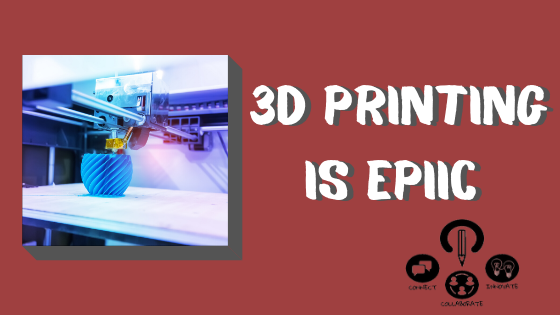Why 3D Printing in the Classroom?
The 3D printing process offers classroom teachers ways to reach high levels of student engagement…offering the ability to engage students at a level that may not be possible to recreate using other materials such as textbooks. The 3D printing process combines problem solving skills with creativity and innovation that supports pedagogy across many disciplines.
With that being said, many of us may not know where to begin. Let’s start with the benefit it brings :
- Students tend to learn better with active learning experiences. The 3D printing process provides experiential learning with more hands-on experiences. Take academic concepts taught in your classroom and make them more practical using the 3D printing process.
- Help students see the value of lessons by incorporating real world understanding through problem solving
- Allows students to fail and learn from their mistakes
- Inspires creativity and imagination
- Enhance students’ spatial intelligence
- Assists in preparing students for future careers by teaching them how to be innovative in our digital world
- Provides life skills such as logical thinking, reasoning, problem-solving, etc.
- Allows for the creation of new or needed learning materials. If you need access to learning materials to help drive your curricular concept that is not available, why not print it.
Now let’s talk about how it fits within our EPIIC Framework:
- Experiential – (DCDS Vision of Experiential – Engaging the Senses: Feel, Touch, Hear, See, Taste): 3D printing provides self-directed experiential learning where students are engaged in direct experiences focused on reflection using these senses.
- Participatory – (DCDS Vision of Participatory – Practice, Perform, Partner): As stated above, the 3D printing process makes learning active. Students are participating collaboratively with the teacher and/or each other to construct learning via the design and printing process
- Interdisciplinary – (DCDS Vision of Interdisciplinary – Perspective Analysis): 3D Models require a file that needs to be created through a Computer Aided Design (CAD) software, so you need to know about the design process, about modeling, about math, about engineering…what a great way to team classes up to work together to further make lessons interdisciplinary.
- Image Rich – (DCDS Vision of Image Rich – Viewing Images/Videos and/or creating): Through the 3D printing process, students will constantly be viewing images in planning and preparation of their designs, and eventually create tangible items
- Connected – (DCDS Vision of Connected – “Real World” Applications): As mentioned above, the 3D printing process helps students see the value of lessons by incorporating real world understanding through problem solving
Finally, let’s conclude with some ideas on how other teachers have used 3D printing in their classroom. Classrooms are using 3D printing to create/recreate:
- Interactive maps
- Tangible models
- Architectural/historical objects or artifacts
- Real-life structures
- Molecular structures
- Human skeleton and/or internal organs
- Decorations/tangible usable items for the classroom such as door stops, containers, etc.
So my answer to the question, why 3D printing in the classroom would be WHY NOT? It offers many tremendous benefits within our EPIIC framework, while igniting or sparking creativity and imagination.
Happy Tinkering!


